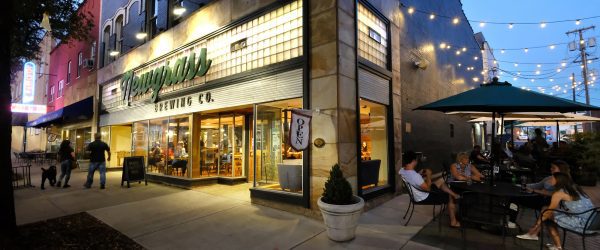Sparking small-town revitalization

These days, we hear a lot about an increasing urban-rural divide across the nation. Yet that wasn’t always the case. At one time, especially in the Charlotte region, cities and small towns were synergistic and interdependent.
Today, however, the landscape is vastly different and we’ve seen those ties fray as offshoring devastated the textile and manufacturing economies. Charlotte has continued to thrive and expand to a global finance hub, while many of the surrounding small towns and rural areas have struggled. In cities across America, urban cores are now booming while their neighboring rural areas struggle. But does it have to be this way?
A Rising Tide: Smart Revitalization
Enter the UNC Charlotte Urban Institute and the Carolinas Urban-Rural Connection Project, a two-year research and community engagement-based project intended to bring understanding to the economic and social interdependence that shaped growth in the central Carolinas. The project’s aim: examine the economic and cultural ties that once flourished between Charlotte and surrounding communities, and explore whether those foundations are strong enough to build a new chapter of regional prosperity.
The Carolinas Urban-Rural Connection Project is built on the premise that there’s more to unite us than divide us—and that a rising tide raises all boats.
Five Key Strategies
Based on research from the Carolina’s Urban-Rural Connection Project, here are five strategies that could point the way to greater regional vitality.
1. Develop unique identities through heritage, culture and natural resources
Whether it’s Shelby’s music-driven revitalization, Cramerton, McAdenville, Great Falls and Badin’s eye to redeveloping around adventure/eco-tourism, or Kannapolis, Gastonia and High Point’s investments in baseball stadiums and downtown cores, successful communities are building themselves up. They can’t replace lost jobs and identities that vanished when the mills left with new industrial employment, so they are finding ways to leverage their other resources to give people around the region a reason to visit or live there.
2. Build up resources and workforce—it isn’t about buffalo-hunting anymore
Economic developers often talk about landing the next buffalo—or elephant or whale—generally meaning a single, big employer with hundreds or thousands of jobs. Communities are now embracing a new mindset about economic development, and investing their resources into education, workforce training, developing amenities and even housing to build up their own workforce, skills and expertise. This approach—of making yourself desirable instead of relying on tax incentives and low cost—offers communities around Charlotte a different path forward. And it could be mutually beneficial: The urban center of the Charlotte region will also benefit from having more cultural and recreational amenities in surrounding communities, which will make the region overall more attractive for investors and companies.
3. Embrace inclusive and committed leadership
Across the region, there are numerous examples of small towns finding success with revitalization. One thing they all have in common: Long-term, committed leaders who champion the community, often for decades. But they also share another trait: Embracing new ideas and leaders. This mixture of steady commitment and openness to new voices seems to be key to success. Fostering connections and dialogue among leaders could help foster this leadership.
4. Remember that the urban connections are key
On their own, small-town efforts aren’t strong enough to fuel economic revival. Rural areas will have to draw visitors from the region, and especially the big, urban center of Mecklenburg County. Fortunately, they’re within an hour of Charlotte, meaning there’s plenty of opportunity. Charlotte and the urban/suburban counties around it are a source for visitors and a market for goods. That’s what agriculture-promoting efforts are hoping to tap into by connecting farmers to regional wholesale markets. And the urban centers are sources of philanthropy and expertise that smaller communities can benefit from tapping into.
5. Realize we all face the same challenges
Research shows that urban and rural counties face similar challenges when it comes to affordable housing. Cross-county commuting has increased 167 percent since 2002, bringing more traffic to everyone. And farmland is being lost to sprawl across the region. These are regional challenges—no county, town or city can face them alone. Solving them will require regional solutions, as well as new ways of approaching how we fund those solutions.
What’s Next?
UNC Charlotte’s Urban Institute will explore these topics in depth at the inaugural Schul Forum Series on Nov. 21, which features acclaimed author and New York Times bestseller Sarah Smarsh. Register by Nov. 15. The cost is $30, and includes light breakfast and lunch.
Photo credit: Nancy Pierce